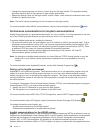
processing a larger frame is only slightly more than the amount needed to process a smaller frame. If
you use larger frames to transfer a single system message or block of data, decreases the total number
of frames required to complete the transfer.
v The values for IOP use in synchronous data link control (SDLC) environments do not necessarily
increase consistently with the number of work stations or with the workload. An IOP can spend more
time polling when the application is not using the line. It is possible to see a relatively high IOP use at
low throughput levels.
v For information on AS/400 configuration, see the Communications Configuration
book.
v For more information on performance tools, see the Performance Tools for AS/400
book.
Improving local area network performance
To achieve better performance with your AS/400 when communicating in a local area network (LAN), you
need to consider the following.
v “Adjusting LANs for optimum communications performance”
v “Adjusting LAN lines for optimum communications performance”
v “LAN line speed considerations for IOPs” on page 10
Adjusting LANs for optimum communications performance
Local area networks (LAN) affect the communications performance on AS/400. Improvements to LAN
input/output (IOPs) in the areas of increased central processing unit (CPU) time, IOP capacity, and support
of IOP assist make them more efficient. This efficiency allows advanced program-to-program
communications (APPC) to send request units to the IOP, passing the processing cost of processing frame
to the IOP.
The following information can help you understand the protocol considerations for local area networks.
v A Data Link Control (DLC) can achieve a significantly higher data rate than other supported line types.
This is due to the desirable combination of having a high media speed along with large frame sizes.
v When several sessions use a line or LAN concurrently, the aggregate data rate may be higher than
when only one session is used.
v To achieve good performance in a multi-user interactive LAN environment, you should manage the
number of active users so that LAN media use does not exceed 50%. (A 25% utilization is
recommended for Ethernet environments because of media collisions that causes the program to loop).
Operating at higher utilization may decrease response time because of excess queueing time for the
line. In a large transfer environment in which a small number of users contend for the line, a higher line
use may still offer acceptable performance.
For more information about AS/400 configuration, see the Communications Configuration
book.
Adjusting LAN lines for optimum communications performance
Several parameters in the line description (LIND) and the controller description (CTLD) play an important
role in system performance that you can change.
The following information can help you to understand the line considerations for local area networks.
v MAXFRAME on the line description (LIND) and the controller description (CTLD): Maximizing the frame
size in a LAN environment supplies the best performance for large transfers. A large frame size does
not negatively affect performance for small transfers. Configure both the AS/400 system and the other
link station for large frames. Otherwise, of the two maximum frame size values, the smaller is used
when you transfer data. Bridges may also limit the maximum frame size. You should change the default
value from 1994 to a larger size.
v LANMAXOUT on the CTLD (for advanced program-to-program communications (APPC) environments):
This parameter governs how often the sending system waits for an acknowledgment. The LANACKFRQ
Chapter 3. Optimizing communications performance 9


















